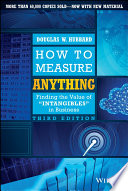

The book begins by challenging the conventional belief that certain things cannot be measured. The author, Douglas W. Hubbard, posits that measurement is not just about numbers but about reducing uncertainty. He introduces the idea that anything can be measured if you define what you want to measure clearly and understand the context. This involves breaking down complex concepts into measurable components, thereby enabling better decision-making. Hubbard emphasizes that measurement is a tool for quantifying the unknown, which allows individuals and organizations to make more informed choices based on data rather than intuition.
Continue readingHubbard articulates the concept of the Value of Information (VoI), which quantifies the benefit of obtaining additional information before making a decision. He explains that understanding VoI can help prioritize what to measure and when. The author provides a framework for calculating VoI, which allows decision-makers to determine how much they should be willing to invest in obtaining information. This idea is crucial in business and technology, where resources are often limited, and making informed decisions can lead to significant competitive advantages.
Continue readingThe book delves into Bayesian thinking as a method for updating beliefs based on new evidence. Hubbard explains that traditional statistical methods often fall short in real-world applications, and Bayesian methods provide a more flexible and realistic approach. By incorporating prior knowledge and adjusting probabilities as new data becomes available, individuals can improve their estimates and predictions. This idea is particularly relevant in fields like data science and machine learning, where adapting to new information is critical for success.
Continue readingHubbard addresses the importance of measuring risk and uncertainty in decision-making. He introduces various techniques for assessing risk, including quantitative methods that allow for a clearer understanding of potential outcomes. The book emphasizes that risk is not something to be avoided but rather understood and managed. By measuring risks, individuals and organizations can develop strategies to mitigate them, leading to more robust decision-making processes. This concept is especially relevant for entrepreneurs and leaders who must navigate uncertainty in their ventures.
Continue readingHubbard provides practical techniques for measuring intangible and difficult-to-measure concepts, such as customer satisfaction, employee engagement, and project success. He offers a step-by-step approach to developing measurement frameworks that can be applied in various contexts. This includes defining objectives, identifying key performance indicators (KPIs), and using surveys and other tools to gather data. The practical nature of these techniques empowers readers to implement measurement strategies in their own organizations, enhancing productivity and effectiveness.
Continue readingThe book highlights the impact of technology on measurement capabilities. Hubbard discusses how advancements in data collection and analysis tools have made it easier than ever to gather and interpret data. He encourages readers to leverage technology to enhance their measurement efforts, whether through software, online surveys, or big data analytics. This idea underscores the importance of staying current with technological trends to improve measurement practices and decision-making processes in today's fast-paced environment.
Continue readingHubbard addresses the cultural barriers that can hinder effective measurement within organizations. He discusses how fear of accountability, resistance to change, and lack of understanding can prevent teams from embracing measurement practices. The author advocates for fostering a culture that values data-driven decision-making and encourages experimentation. By overcoming these cultural challenges, organizations can unlock the full potential of measurement and improve their overall performance.
Continue reading